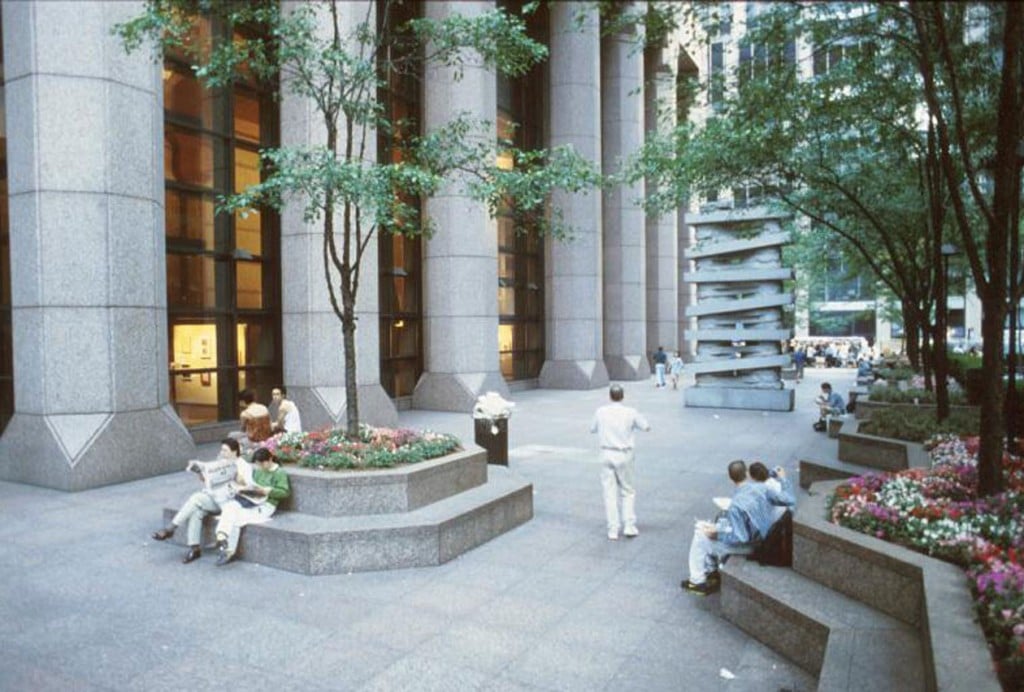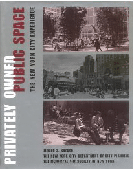
31 West 52nd Street
Visually and functionally, the primary portion of this urban plaza is the wide, outdoor through-block corridor connecting West 52nd and 53rd Streets, east of Sixth Avenue between the CBS building to the west and the Deutsche Bank building to the east. Changes to the “as-of-right” plaza zoning regulations in 1975 and 1982 introduced enhanced amenity and design requirements for plazas at office buildings in midtown, including a general prohibition against north-facing spaces. The need for such a prohibition had become obvious. Plazas obtained under the “as-of-right” 1961 plaza rules could face north, and such an orientation too often created dark, cold, relatively inhospitable places.

Although it appears that this urban plaza has southern frontage on West 52nd Street, this is not the case. In fact, a large piece at the southwest corner of the space actually is part of the CBS building zoning lot. Thus, in the eyes of zoning, the Deutsche Bank urban plaza came to a dead end substantially north of West 52nd Street frontage, and thus would have been legally prohibited. Because it is impossible for planners and lawyers to anticipate every development permutation, zoning amendments become necessary correctives. It is not uncommon for new and unexpected fact patterns to trigger reexamination of existing zoning rules. Here, because the plaza could de facto, if not de jure, secure south-facing frontage if it could make an arrangement with CBS to use some of its zoning lot, it would make little sense to prohibit it. Thus, the City Planning Commission in 1983 approved a zoning amendment allowing a north-facing urban plaza, such as the one here, if “such plaza is contiguous to an open area fronting on a south facing street line on an adjoining zoning lot to form a ‘through block plaza.’” The owner of the Deutsche Bank building zoning lot entered into an agreement with the owner of the CBS building zoning lot that permitted the Deutsche Bank building owner to add 4,167.22 square feet of CBS lot to its urban plaza, thereby forming the through-block plaza required by the zoning. Form and substance became one.
The urban plaza is formal, even austere, in its appearance. Where the surfaces of public spaces are sometimes all brick or all concrete, the surfaces here are all granite, interrupted briefly by dashes of colorful flowers. Seven imposing red-granite piers rise four stories along the building lobby to the east, deemed by one critic as “Aztec/Egyptian temple” post-modern. At the western edge across the granite floor is a block-long serpentine seating ledge with a back that serves as planter wall for a row of trees and colorful flowers. At north and south ends of the corridor are small planters with built-in benches, trees, and flowers. Halfway between West 52nd and 53rd Streets is a 22-foot-high sculpture entitled Lapstrake (1987), by sculptor Jesus Bautista Morales, composed of horizontal polished granite slabs alternating with slabs and pieces of rough-hewn granite.
The connection between the CBS building, popularly known as Black Rock, and the Deutsche Bank building, is not solely a matter of zoning. Access between this urban plaza and the CBS plaza is provided down several steps. Furthermore, the CBS building was designed by Eero Saarinen, the Finnish-American architect known, among other things, for his flowing airline terminals at Kennedy and Dulles Airports, in collaboration with architects Kevin Roche and John Dinkeloo. The Roche-Dinkeloo firm also designed the Deutsche Bank building, first known as the EFHutton building. Additional urban plaza may be found in the form of more sidewalk on West 52nd and 53rd Street sides of the building.

